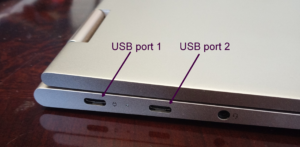
Quite often when I find that some consumer electronic device that I purchased has a really nice or clever feature, I realize that this is not at all due to my somehow having been a savvy purchaser, but instead that it is due to dumb luck. This really nice feature of my new Lenovo Yoga notebook computer falls into the “dumb luck” category.
The background to this is that over the years I have very often run into a situation where the charging port on a notebook computer gets old and tired. This port is, after all, the port that gets used much more often than any other port on the computer. So it is subject to physical impacts and other things that shorten the life of the port. On one occasion I had no choice but to replace a mother board for no better reason than that this was the way to get a fresh start on a new charging port.
So imagine my pleasant surprise when I realized that this computer can be powered and charged up using either of the two USB type C ports shown in the photograph. This means that if one port were to get banged up some day and stop working, I would still be able to use the other of the two ports for powering and charging.
Another advantage that flows from the fact that the charging is by means of a USB type C port (instead of the more usual choice that most manufacturers make, which is to use a proprietary port) is that I can very easily make use of any of a large number of computer power adapters made by various companies. This tends to keep down the price of a spare power adapter. After all, one of the first things that a person has to do when the get a new notebook computer is to purchase half a dozen spare power adapters. The idea is that one or two remain permanently in the office, another one or two remain permanently at home, one or two remain permanently in one’s “go bag” and so on.
The next time you are shopping around for a new notebook computer, I invite you to include this feature on your list of desired features — that the computer can be charged or powered through either of two ports, and that the interface is the standardized 65 watt or 100 watt USB C interface.

Do note that as I found out this last week while traveling (when my computer and its charger decided to stop liking each other), that most, if not all, computers that can be charged through the USB-C port require not just the USB-C cable, but a converter (the thing you plug the other USB end into) that delivers a high voltage… more than the usual small little plugs and integrated USB plugs in hotel rooms can deliver.
Yes you are are absolutely right about that. The power adapter needs to be able to generate something like 17 volts or 19 volts, and the ordinary little USB type B outlets (the rectangular ones) in hotels and such only provide five volts. Thank you for posting!
I am glad to now have this model Lenovo computer, since my last computer became inaccessible due to the port wearing out after five years.
Glad the usefulness of multiple USB-C ports and charging thereby is spreading.
(My Dec2016 Macintosh Mac Book Pro has 4 USB-C ports (they also accommodate a few other electrical format).
And any of the four USB-C ports can be used for powering and charging your computer? Nice!